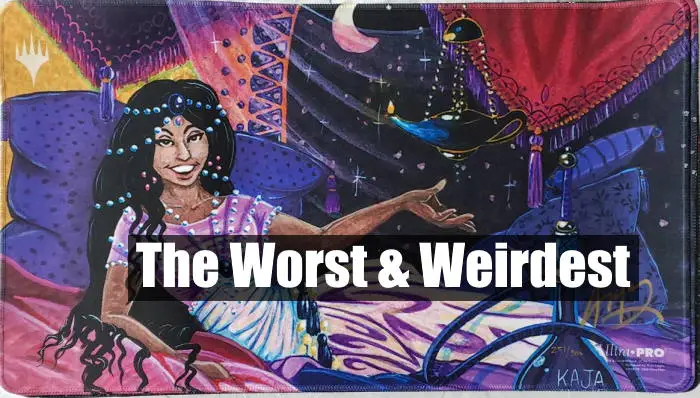Over the course of Magic’s thirty year history, Wizards of the Coast has printed plenty of amazing, game changing cards. They’ve also printed plenty of weird, confusing, and downright bad cards as well. In this article, I’ll give my picks for the weirdest and worst magic cards ever.
Magic cards can be bad and/or weird for a number of different reasons. The most common reasons are underwhelming or harmful effects, and super high mana-costs. These are by no means, however, the only factors.
Whatever the reason, the cards on this list are all either terribly bad, or terribly weird. Lets get right into it!
Table of Contents
Worst Magic Cards Ever
Zephyr Spirit
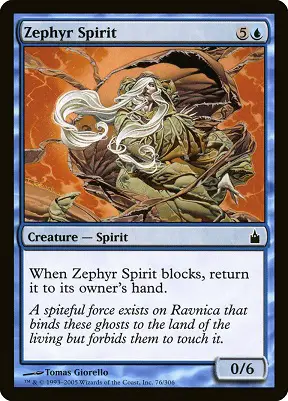
First up on our list, Zephyr Spirit is pretty awful in almost all circumstances. It has six toughness, but zero power, and it costs a whopping six mana to cast. Then, as if the stats weren’t bad enough, it has a downside. Whenever you block with it, you have to return it to your hand.
So you’re telling me I paid six mana for a 0/6 creature, got to block with it once, and now I have to pay another six mana to cast it again? Great.
The one possible saving grace of Zephyr Spirit is that it has the Spirit creature type. In the Kamigawa block where it was printed, lots of cards give you a bonus anytime you cast a Spirit spell. Zephyr Spirit can be cast multiple times since it comes back to your hand every time you use it to block. This means that Zephyr Spirit might have been acceptable if you were drafting a Spirit deck and really needed an extra Spirit.
That said, however, six mana is still way too much to make Zephyr Spirit plausible. 99.9% of the time, Zephyr Spirit is going to be just awful. Wizards could have made it cost half the mana, and it still probably wouldn’t see play anywhere.
Shinka Gatekeeper
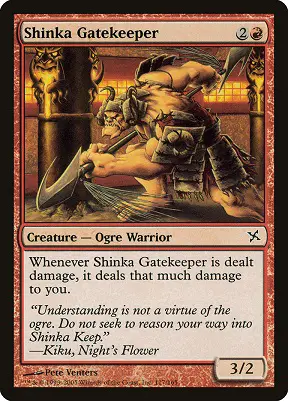
Shinka Gatekeeper doesn’t have terrible stats. A 3/2 creature that costs three mana isn’t mind-blowing, but it’s not awful either.
Shinka Gatekeeper really only starts stinking the place up whenever he gets dealt damage. For some reason, he has to deal all the damage he’s dealt back to you. Some kind of Gatekeeper, huh? Any time he gets hurt he decides to give you a little punishment as well. Appreciate it Gatekeeper.
I don’t know how this makes sense, flavor-wise, or mechanically. The only time I could see Shinka Gatekeeper maybe being okay is in some kind of Death’s Shadow deck where you want to get your own life-total as low as possible. Other than that, though, Shinka Gatekeeper is just a downright bad card.
Cocoon
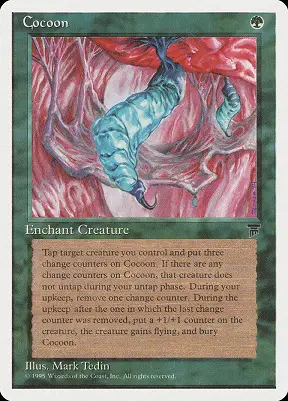
I could see where Wizards of the Coast was going with Cocoon. It’s pretty cool flavor-wise. You get to tuck one of your creatures away in a cocoon for a few turns, and then when it comes out, it emerges stronger than ever.
That’s all fine and good in theory, but in practice, Cocoon keeps your creature tapped for way too long (four turns effectively), and gives it way too small of a bonus (+1/+1 and flying).
Cocoon is so good at shutting down creatures that, if it were allowed to target your opponent’s creatures, it would make a really powerful removal spell. As it turns out, it’s a powerful removal spell that you can only cast on your own creatures.
I wonder how many poor new players used Cocoon to effectively two-for-zero themselves during the most important turns of the game back in the day. Poor souls.
Juju Bubble
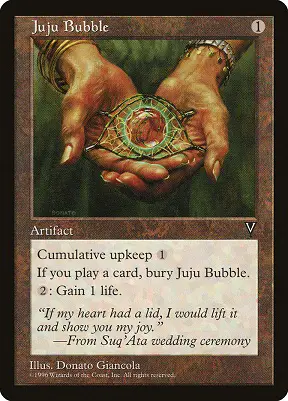
Juju Bubble is truly underwhelming, even before you consider either of its downsides. It only costs one generic mana to cast. Okay, that’s not bad. But, then you have to pay two more mana if you want to activate it.
So now you’ve paid three mana, and . . . you get to gain a whopping 1 life. Wow. That’s way too powerful. It’s a good thing Wizards of the Coast decided to add a few crushing downsides to balance it out.
The first downside is that it has Cumulative Upkeep 1, meaning you have to pay more and more mana on each of your upkeeps to keep Juju Bubble in play. And then, any time you play a card, you have to destroy Juju Bubble. They used the word play instead of cast too, so even if you just drop a land you can kiss your Juju Bubble goodbye.
Why Wizards decided to heap downside after downside onto this already bad card, the world will never know.
RELATED: The Best Dominaria United Cards: Spoilers Overview
Razor Boomerang
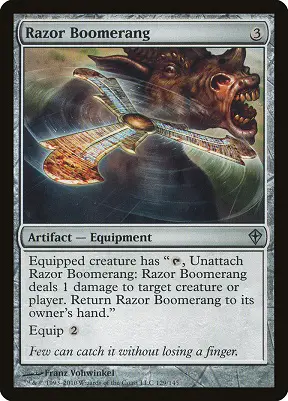
It’s hard to imagine why Razor Boomerang was ever printed. It’s an equipment that costs 3 mana to cast, and then another 2 mana to equip. Then, you can tap the equipped creature, and unequip the Boomerang to deal a devastating 1 damage to target creature or player. Then, you have to return Razor Boomerang to your hand.
So let’s get this straight, you have to pay a total of five mana and tap one of your creatures to deal one damage? And then the boomerang goes back to your hand, where you’ll have to pay its costs all over again? Yeah, no thanks.
It seems like whoever created this card was trying way too hard to capture the flavor of a “Razor Boomerang”. But even then, why does the boomerang have to go back to your hand? Why can’t it return to the creature that it’s equipped to? Why can’t it deal more than 1 damage? And why does it cost so much to cast and equip? So many questions, so few answers. All we know for sure is that Razor Boomerang is bad.
Dispersing Orb
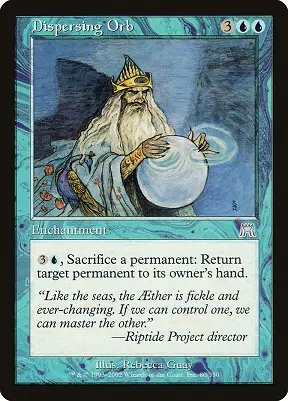
Dispersing Orb lets you bounce one of your opponent’s permanents. That’s pretty good right? Not in this case. Not at the price Dispersing Orb is asking.
First of all Dispersing Orb costs five mana to cast, which is a lot. Then, to activate its ability, you have to pay an additional four mana and sacrifice one of your permanents.
Pay nine mana and sacrifice a permanent just to return one permanent to your opponent’s hand. Doesn’t seem like a great trade to me.
Of course, Dispersing Orb maybe could have had potential in an aristocrats style deck where you want to sacrifice small creatures anyways, if the mana-cost wasn’t so big.
As is, Dispersing Orb just asks so much for so little in return, making it truly one of the worst Magic cards ever.
Sorrow’s Path
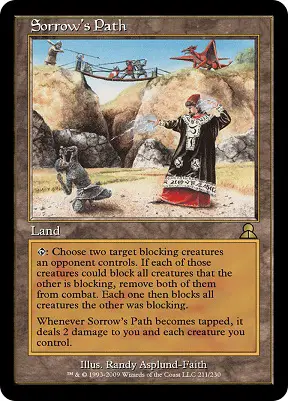
Here we are, the worst of the worst. That honor, in my opinion, goes to none other than the dreadful Sorrow’s Path. First off, the card says: “Choose two target blocking creatures an opponent controls. If each of those creatures could block all creatures that the other is blocking, remove both of them from combat. Each one then blocks all creatures the other was blocking.”
Then, as if that horribly worded, underwhelming effect wasn’t bad enough, they nonchalantly throw this ridiculous downside down at the bottom: “Whenever Sorrow’s Path becomes tapped, it deals 2 damage to you and each creature you control.”
Excuse me? 2 damage to me and every single one of my creatures every time it’s tapped? Just so I can switch two of my opponents blockers around? If I keep using Sorrow’s Path my opponent won’t need any blockers, because I won’t have any attackers, because Sorrow’s Path killed them all.
Sorrow’s Path is the worst Magic card ever, plain and simple. It’s not just that it’s overpriced, or that it wastes your turn. Sorrow’s Path does pretty much nothing to your opponent since they know it’s coming and can play around it, and it actively kills you and all of your creatures every time you use it. The only thing it brings Sorrow to, is any Magic player unfortunate enough to include it in a deck.
RELATED: The Best Lands In MTG: A Complete Guide
Weirdest Magic Cards Ever
Floral Spuzzem
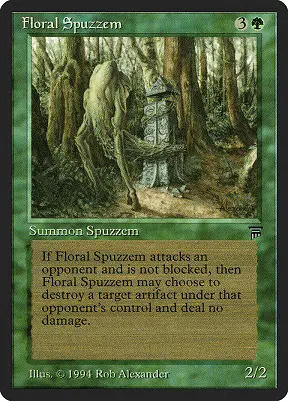
What makes Floral Spuzzem one of the weirdest Magic cards ever is its wording. The card reads: “If Floral Spuzzum Attacks a player and is not blocked, then Floral Spuzzem may choose to destroy a target artifact under that opponent’s control and deal no damage.”
Floral Spuzzem may choose, not you. Apparently, Floral Spuzzem is the first and only sentient Magic card in the world.
Boy is it stressful sitting back after an attack, hoping that it makes the right choice.
Wizards of the Coast has, of course, given Floral Spuzzem an updated Oracle Text. The text on the physical copies of the card, however, will forever be hilarious.
Dead Ringers
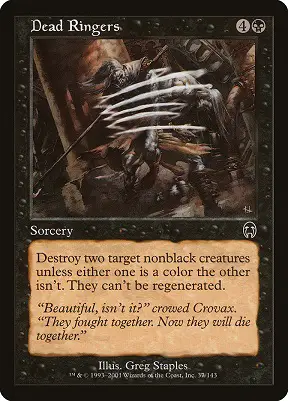
Dead Ringers isn’t that terribly weird of a card, but it is extremely confusing at first, which I feel is enough to earn it a spot on this list.
Dead Ringers says: “Destroy two target non-black creatures unless either one is a color the other isn’t. They can’t be regenerated.”
If you made sense of that on the first read-through, you’re a lot smarter than I am.
This card text reminds me of the line from Bilbo Baggins’ speech to his friends and family in Lord of the Rings. “I don’t know half of you half as well as I should like; and I like less than half of you half as well as you deserve.” It’s simple once you figure it out, but it’s extremely confusing before you manage to do so.
What Dead Ringers is trying to say is this: Destroy two target non-black creatures if they’re exactly the same color or combination of colors. Why they had to make the card-text a riddle is beyond me. Who knows, maybe old Bilbo Baggins designed the card.
Chaos Orb
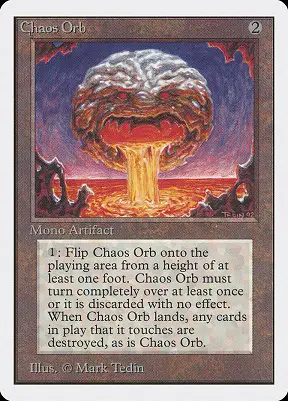
Chaos Orb is one of the most well-known weird cards in the entire game. You pay one mana to activate its ability, and then you pick the card up and drop it from a height of at least one foot, making sure Chaos Orb does at least one flip in the air. Then, whatever cards Chaos Orb lands on are destroyed.
I don’t think I have to explain to you how ridiculous this effect is. First off, there are no rules stating how close or how far players can keep their cards on the battlefield; so what’s to stop your opponent from just moving all of their cards as far apart as the table will allow as soon as you play the Orb?
Wizards of the Coast has, of course, banned Chaos Orb in every format, but it’s still crazy to think that physically flipping a card onto other cards was ever a real part of the game.
Goblin Game
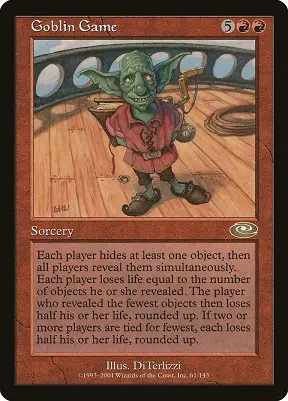
Goblin Game is almost certainly the weirdest Magic card that is still legal today.
The text for Goblin Game reads: “Each player hides at least one item, then all players reveal them simultaneously. Each player loses life equal to the number of items they revealed. The player who revealed the fewest items then loses half their life, rounded up.”
Okay, so we’re really hiding physical items? How far do we have to go away from each other? Do we have to remain in each other’s sight? If so, how do successfully hide anything?
Everything about this card is just crazy, and I honestly can’t believe it’s legal in any format, but it is.
That said, however, the concept behind Goblin Game is really fun and I think it’s a super cool card. The design team probably should have went with some other way to make the mini-game function aside from hiding items, though. Having each player secretly write down a number could have been a better alternative.
In addition to being one of the weirdest cards ever, Goblin Game is also one of the worst cards in the game. After all, it costs seven mana, and if you lose the Goblin game, you’re going to lose over half of your life. Even if you win, it’s still going to deal some damage to you. I can think of so many better ways to spend seven mana.
Shahrazad
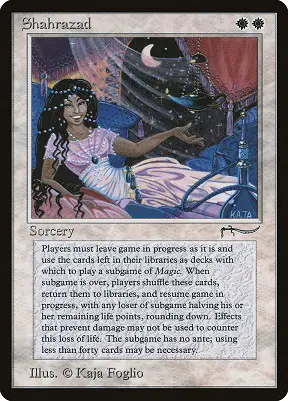
Shahrazad makes players pause the current game and play an entirely new subgame using their remaining library. Whoever loses the subgame then loses half of their life, and the original game of Magic continues.
Can you imagine playing a best-of-three series against someone using multiple copies of Shahrazad? It would be very easy to play two or three subgames every single game! And it’s even likely to play a sub-game within a sub-game. Imagine playing eight or nine games of magic just to finish one series.
The flavor of Shahrazad is actually really cool. Shahrazad is the main character of A Thousand and One Nights, a piece of medieval Arab literature in which a woman delays her execution every night by telling a story to the king. Each night she stops her story on a cliffhanger, and the king, eager to hear the end, spares her life until the following day. After a thousand and one nights, Shahrazad finally runs out of stories to tell. At that point, however, the king has fallen in love with her and decides to make her his queen, sparing her life for good.
So, basically, Shahrazad allows Magic players to delay their own execution indefinitely by playing countless games within games. Really awesome flavor, not so awesome for actual gameplay.
Nowadays, Shahrazad is banned in all formats, and the card is so expensive that it probably doesn’t see very much casual play. It will, however, always have a special place in the hearts of Magic players as one of the weirdest cards of all time.
RELATED: The Best MTG White Tutors
End Step
That’s it. I hope you enjoyed this list. If there’s a really bad or weird card I forgot, drop a comment below and tell me about it.
Until next time, have fun with all the good, the bad and the weird Magic: the Gathering has to offer!
